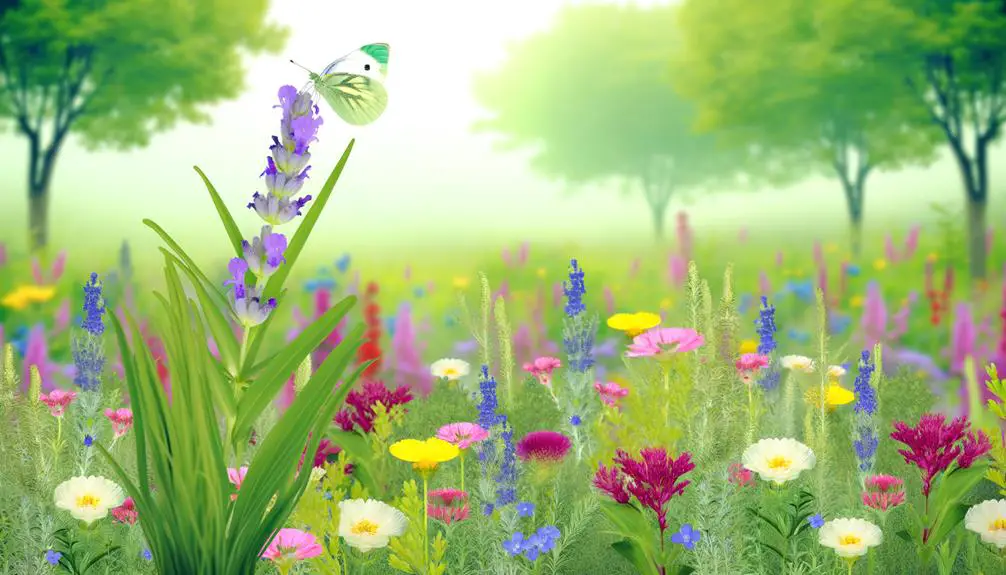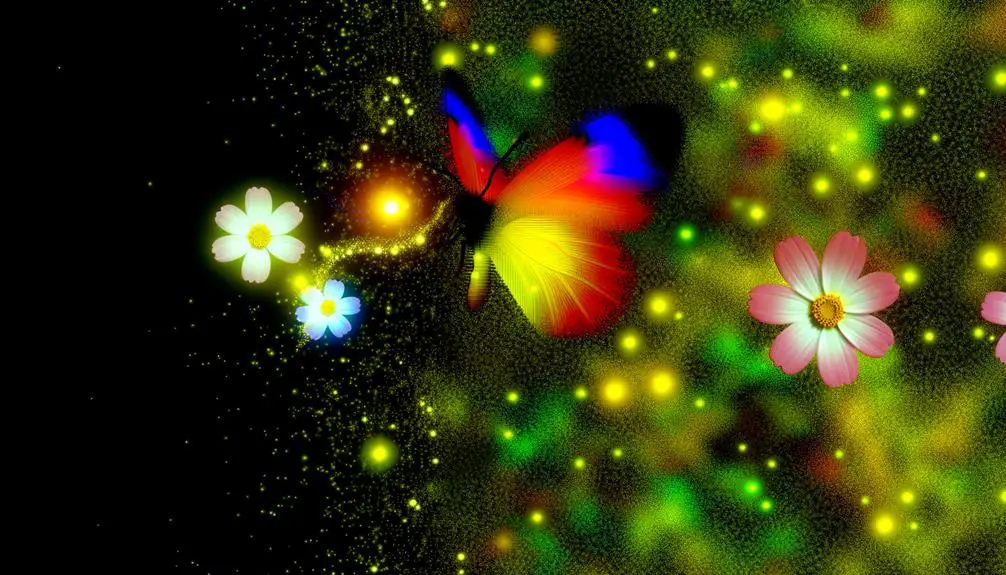How Does a Butterfly’s World Smell Like?
Butterflies exhibit species-specific scents produced by specialized androconial glands, essential for mating and intra-species communication. These scents consist of pheromones, volatile organic compounds serving multiple functions, including courtship and territory marking.
Environmental variables like temperature and humidity greatly influence pheromone stability and dispersion. Butterflies also interact with plant nectar, with its chemical composition affecting their scent and energy dynamics.
Consequently, butterfly smells are complex, multifaceted, and highly dependent on the interplay of biological and environmental factors. Their intricate olfactory systems provide intriguing insights into their behaviors and ecological interactions.

Key Takeaways
- Butterflies emit species-specific pheromones via specialized androconia glands.
- Male butterflies release sex pheromones with scents unique to each species.
- Volatile organic compounds in pheromones can deter predators.
- Environmental factors like humidity and wind influence the scent's strength and dispersal.
Butterfly Scent Production

Butterflies produce scents through specialized glands known as androconia, which are typically located on their wings or abdomen.
These androconial glands secrete pheromones, essential for mating and intraspecific communication. The chemical composition of these pheromones is highly species-specific, ensuring effective communication within the same species.
Observations indicate that the release of these scents often occurs during courtship behaviors, facilitating mate attraction.
Detailed studies have identified various compounds, including esters, alcohols, and terpenes, as principal components.
The deployment of these scents involves complex behaviors, such as wing fanning, to disperse the chemical signals over a wider area.
This intricate system underscores the significance of chemical communication in the reproductive success and social interactions of butterflies.
Role of Nectar
Nectar serves as a primary energy source for butterflies, providing crucial carbohydrates required for sustained flight and metabolic activities. The composition of nectar varies among plant species, influencing the attractiveness and feeding behavior of butterflies. Key components include sugars such as sucrose, glucose, and fructose, along with amino acids and vitamins.
| Component | Function | Impact on Butterfly |
|---|---|---|
| Sucrose | Primary energy source | Enhances flight endurance |
| Glucose | Quick energy release | Supports immediate activity |
| Fructose | Sustained energy | Prolongs feeding sessions |
| Amino Acids | Protein synthesis | Aids in reproduction |
| Vitamins | Metabolic regulation | Boosts overall health |
Understanding nectar's role highlights its significance in butterfly ecology and behavior.
Pheromones and Communication

Pheromones play a pivotal role in butterfly communication, facilitating mating behaviors, territory establishment, and social interactions through chemical signals. These volatile compounds are released by specialized glands and can be detected by conspecifics via their antennae.
Observations indicate that pheromones serve several critical functions in butterfly ecology:
- Mating Attraction: Males often release sex pheromones to attract females, ensuring reproductive success.
- Territory Marking: Males delineate territorial boundaries using pheromones, preventing conflicts and optimizing resource utilization.
- Social Hierarchies: Chemical signals help establish social structures within populations, influencing behaviors such as feeding and migration patterns.
These intricate chemical communications underscore the complexity of butterfly interactions and their reliance on olfactory cues for survival and reproduction.
Environmental Influence
Environmental factors profoundly affect the olfactory communication systems of butterflies, influencing the production and detection of pheromones. Variations in temperature, humidity, and wind patterns can greatly alter pheromone dispersal and efficacy.
Elevated temperatures may increase pheromone volatility, enhancing signal strength but reducing longevity. Conversely, high humidity can slow evaporation rates, prolonging the signal's presence. Wind direction and speed further complicate these interactions by dispersing pheromones over wider or more concentrated areas, impacting mate location efficiency.
Additionally, environmental contaminants such as pollutants can interfere with the chemical integrity of pheromones, disrupting communication. The interplay between these environmental elements necessitates adaptive mechanisms in butterflies, ensuring successful reproduction and survival despite fluctuating conditions.
This complex relationship underscores the sensitivity of butterfly olfactory systems to their habitats.
Unique Butterfly Fragrances

How do butterflies produce such a diverse array of fragrances, each uniquely tailored to their specific ecological and reproductive needs? The secret lies in their specialized scent glands. These glands secrete pheromones and other volatile organic compounds (VOCs) that facilitate communication and mating.
- Pheromones: Male butterflies often release sex pheromones to attract females, ensuring reproductive success.
- VOCs: These compounds can serve multiple roles, from deterring predators to marking territory.
- Glandular Diversity: Different species have evolved distinct gland structures, leading to unique scent profiles.
Detailed observations show that these fragrances are often species-specific, indicating a high level of evolutionary adaptation.
Understanding these biochemical mechanisms provides insight into the complex interplay between butterflies and their environment.
Conclusion
To summarize, the olfactory profile of butterflies, a subject of profound scientific inquiry, encompasses the aromas derived from nectar, the intricate pheromonal communication systems, and the multifaceted environmental interactions. These sensory perceptions play a crucial role in their survival, aiding in locating food sources and identifying suitable mates. Butterflies and their sense of smell are finely tuned to detect specific floral scents and pheromones, enabling efficient navigation through their ecosystems. This olfactory sensitivity also helps them recognize potential threats and adapt to changing environmental conditions.
One might jest that butterflies, in their quest for survival, have become inadvertent perfumers, blending floral notes with an array of chemical signals.
Such complexity in scent production defies simplistic interpretations, inviting further investigation into these winged chemists of the natural world.






